HAPPY EASTER! This is a few years ago from our favorite cruising Easter (Semana Santa). Portobelo, Panama. Enjoy and have a Happy & Blessed Easter!
*******
Dolphins soar out of the water, turning a complete flip ending in a splash that puts the Seaworld dolphin show to shame. But the background isn’t the stage at Seaworld, it’s the ancient town of Portobelo, Panama. From the jungle shoreline, we can hear the howls of the howler monkeys, – unheard since we left the Chagres River in October! Winterlude is anchored across from town where three freshwater rivers wind their way down from the mountains that frame the bay. It’s a large bay with an entrance free from obstructions: a welcome relief for the seamen aboard Christopher Columbus’ “la Capitania”, the flagship for his fourth trip to the New World in 1504. As a tropical storm raged outside, Columbus’ four little ships literally were blown into the harbor, expecting to be wrecked at any moment … instead finding themselves inside a large
beautiful bay surrounded by mountains protecting them from the howling winds. In his relief to be safe, Columbus proclaimed “Puerto Bello” – translation: “beautiful port”! With variations in spelling, the name stuck through the past four centuries.

Portobelo became one of the most important ports in the Spanish Main … shipping lanes that brought millions of pounds of Inca treasure: gold, silver & platinum back to Spain. Treasure was collected from as far away as Peru, sent via ship to Panama City on the Pacific side, then hauled overland by mule via the Camino Real – a muddy dangerous trek through the mountains. Spanish galleons arrived once a year transforming Portobelo, from a sleepy fishing village with no more than a hundred houses, into a bustling port teeming with thousands of people. We climbed all through all four forts dating from the 1500’s to 1700’s – all three levels of each, meaning that the two top levels which were located HIGH on top of a small mountain required a hike up an almost vertical path to reach. Now here’s a question for you … why did the Spanish think it was necessary to build a moat around a fort at the very top of a mountain!
Silver bars & gold pieces accumulated for months prior to the event called “The Fair”. The Spanish built the “Aduana” house – a HUGE structure, two blocks long, for storing “treasure”. But the treasure, mostly silver bars were stacked outside in the streets around the building while inside was food, offices and other necessities. It must have been quite a sight to see thousands of dollars worth of silver bars stacked 5 feet high & streets deep around the customs house at “Fair” time!
Today Portobelo has a population of 1000, only 300 more than in Columbus’ time. And despite the fact that electricity has arrived, it’s still mostly a sleepy fishing village. (Speaking of electricity, I went to the one room library today to use the internet & 10 minutes after I started, the windowless room went totally black … electricity it appears is a sometimes thing!) There’s a small restaurant internet café here that bakes fresh French bread every afternoon. Cruisers dinghy in each morning to put in their order, otherwise there’s never enough hot French bread to go around!

Portobelo is also known for El Nazareno, or the Cristo Negro … a life size statue of Christ that has become an icon for miracles. Pilgrims travel from all over Panama to ask El Nazareno to cure their ailments on October 21 annually. The pilgrimages began following the cholera epidemic in the early 1800’s. The cholera epidemic decimated entire communities all up & down the Panamanian Caribbean coast, but Portobelo escaped without losing a single life. As word spread, the miracle was attributed to El Nazareno & the statue’s popularity took on a life of it’s own. Today El Nazareno comes out of his glass case in the ancient church twice a year … once for the Cristo Negro (Black Christ) procession in October and again for Semana Santa – Easter Week. We were lucky enough to see the Easter Week processions – 50 men – 25 on each side – carry the huge platform with El Nazareno bearing the cross through the two main streets of Portobelo. A band follows and after the band, the entire community joins the procession. Thousands of lit candles sway to the music – hundreds on the El Nazareno platform and individual candles in every person’s hand. This procession is so important to the lives of this community that little kids build their own mockups of the huge platform and
practice the three steps forward, two backward sway that the men use during the actual festivities – in hopes that they will be selected for the honor of carrying the real thing when they grow up.
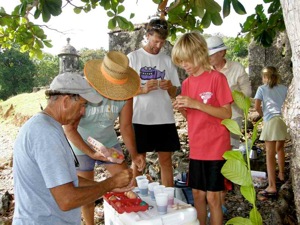
During Semana Santa, we joined two “kid” boats anchored in the harbor & colored easter eggs in the shade of the almond tree in front of Fort San Fernando opposite town. Easter Sunday afternoon we enjoyed an Easter Egg hunt and potluck meal. Unfortunately, the men got carried away hiding easter eggs in the 17th century fort & only twenty six of the twenty seven eggs were found, leaving one for the iguanas. How many people are lucky enough to enjoy the adventure of an easter egg hunt in a 17th century fort! J After the hunt, we had an “egg tapping” contest – apparently this is a tradition in upstate New York … everyone selects their favorite egg (hard boiled & already decorated) and taps them end to end. One will crack & one will not, the winner goes on to the next round until there’s only a single egg left. After egg tapping, the British boys, Finn & Laurie, wanted to do a British tradition… rolling the eggs down a large hill. All the kids climbed to the top level of the fort & commenced rolling eggs down a steep slope to the lower fort. A most enjoyable Easter!
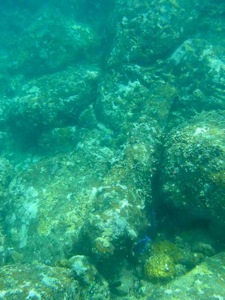
Because it’s such a large bay, there are often two dozen or more cruising boats anchored here. Portobelo is the end of the road for people backpacking the Transamerican Highway from the top of Alaska to the bottom of South America, or anywhere in between. The only gap in the road is in the Darian jungle, Panama. So those biking or riding motorcycles across continents are at a dead end. Backpacker sailboats fill the gap, providing transportation across the gap to where the road resumes. These boats are entertaining to watch, usually overloaded – maybe six full size people and a motorcycle on a 30 foot sailboat. We always wonder if these people have any idea that sailing is not for unseaworthy craft and that Mother Ocean can be ruthless when the weather turns bad. There’s one boat in particular that cruisers label “Dennis the Menace” for his habit of dragging anchor through anchorages. We’ve seen this boat in three different harbors and watched him drag three different times. And we’re not talking about dragging anchor for a boatlength or two, Dennis drags anchor for miles! All the way across bays, often creating a hazard for other boats unlucky enough to be anchored behind him. But watching them load full size motorcycles on board from a typical inflatable dinghy nine or ten foot is quite entertaining!
Much as I HATE doing hand laundry … which, by the way, now we haven’t seen a washing machine since November 13 (have I mentioned this in prior updates) … that’s 120 days with no laundry except hand laundry. … nothing is ever CLEAN, but everything is CLEANER! J BUT we have
discovered that there are wonderful places in the world that you simply cannot visit unless you’re willing to endure some lack of modern conveniences. Oh, to be sure, there IS a laundry facility in Portobelo … 4 washers & 2 dryers, 50 cents a load which is cheap, BUT … frequently there’s no water, and that’s assuming there IS electricity! When there is water, you have to get there before 7 AM when it opens or fight a line several women long with 8 loads each… so I continue to do hand laundry… On the other hand, there’s the wreck of the Vizcaina, one of Columbus’ 4th voyage galleons that sunk just beyond the opening to the bay at Portobelo and Rayene reports seeing sunken cannons when she snorkeled there before… sure enough, snorkeling the reef there are two Spanish cannons encrusted with coral in about ten feet of water. Wow, Spanish treasure all for the price of a bit of hand laundry. Most worthwhile!!!

Unfortunately, nothing ever stays the same for long. Part of the fun of cruising is sharing the fun & creating cruising memories with friends … but the hard part of cruising is parting. Since Kristiana greeted Winterlude in the Rio Chagres on October 17, the two boats have not been anchored out of whistling distance for more than a couple of nights. But now Kristiana is waiting on a weather window to head up to SanAndres, Columbia, the Vivorillos, Honduras and on to the Rio Dulce in Guatemala. And on April 1, Winterlude will sail back to Colon & Shelter Bay Marina to put Winterlude on the hard and return to the U.S. for Y Flyer (one design racing) season.
Kristiana sailed out of Portobelo with David blowing (rather weakly) a traditional conch horn salute as a goodbye. Hopefully we’ll catch up with them later this year to explore Peru, the Inca Trail & Machu Picchu on a land adventure.
Until next time! Winterlude, Portobelo, Panama
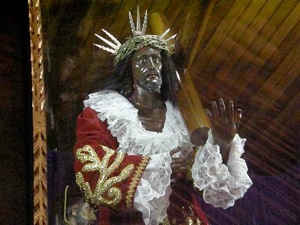

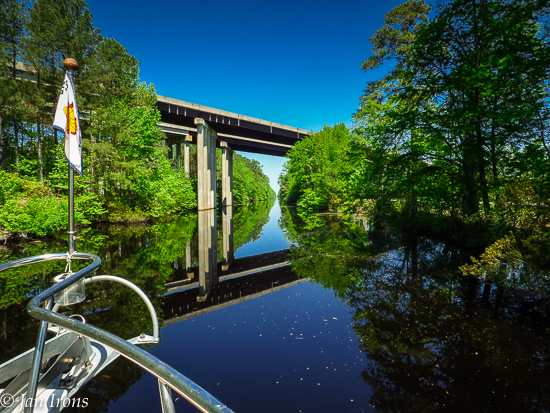








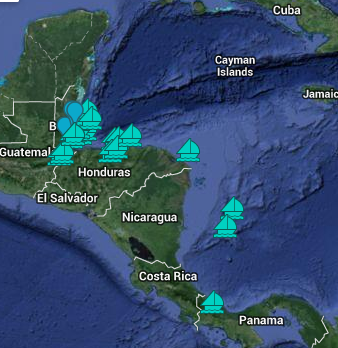
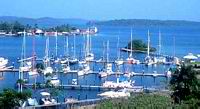
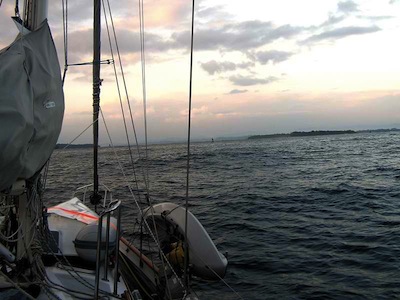
… [Trackback]…
[…] Find More Informations here: commutercruiser.com/easter-semana-santa-in-portobelo-panama/ […]…